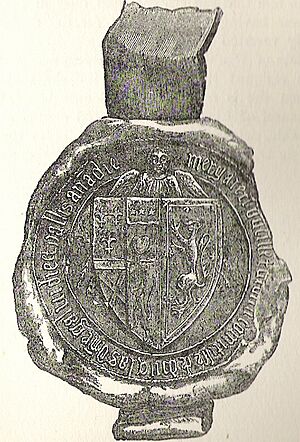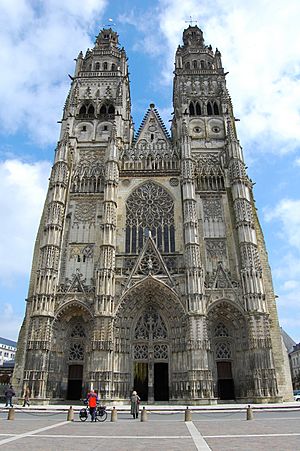Archibald Douglas, 4th Earl of Douglas facts for kids
Quick facts for kids
Archibald Douglas
|
|
|---|---|

Seal of the 4th Earl of Douglas
|
|
| Born | c. 1369 |
| Died | 17 August 1424 Verneuil, Normandy, France
|
| Cause of death | Slain at the Battle of Verneuil |
| Resting place | Cathedral of St Gatien, Tours, France |
| Title | Earl of Wigton Lord of Galloway Lord of Annandale Lord of Bothwell 13th Lord of Douglas |
| Spouse(s) | Margaret of Scotland |
| Children | Archibald Douglas, 5th Earl of Douglas Elizabeth Douglas William Douglas James Douglas Marjory Douglas |
| Parents |
|
| Family | Clan Douglas |
Archibald Douglas, 4th Earl of Douglas (born around 1369 – died August 17, 1424), was a very powerful Scottish nobleman and military leader. He was also known as the Duke of Touraine in France. Some people called him "Tyneman," which means "Loser" in old Scottish. However, this nickname might have been for his great-uncle, also named Archibald Douglas.
Contents
Early Life and Family
Archibald Douglas was the oldest son of Archibald the Grim, 3rd Earl of Douglas and Joanna de Moravia. He was likely born at Bothwell Castle around 1369. Before he became Earl, he was known as the Master of Douglas.
Around 1390, he married Princess Margaret of Carrick. She was the daughter of King Robert III of Scotland. His father gave him control over large areas like Ettrick Forest and Lauderdale.
In 1400, King Robert made him the permanent Keeper of Edinburgh Castle. He received a payment of 200 merks (an old Scottish coin) each year for this important job.
Important Events and Battles
Fighting the English

In 1400, English forces led by George I, Earl of March and Henry 'Hotspur' Percy attacked Scotland. They burned villages and tried to capture Hailes Castle. Archibald Douglas, who was in charge of defending the border, surprised them at night. He defeated the English and chased them all the way to Berwick upon Tweed. Many English soldiers were killed during their retreat.
Later that summer, Douglas helped defend Edinburgh Castle against an invasion by King Henry IV. King Henry failed to capture the castle. He was the last English king to personally invade Scotland.
Becoming a Powerful Earl
In late 1400, Archibald's father, the 3rd Earl, passed away. This made Archibald the 4th Earl of Douglas. He became the most powerful noble in Scotland. His family's lands stretched across much of the country. He also gained lands that had been taken from the Earl of Dunbar.
A Royal Mystery
In 1402, Douglas's brother-in-law, David Stewart, Duke of Rothesay, was arrested. Duke David was the heir to the Scottish throne. He died while imprisoned at Falkland Palace. His death was very mysterious.
Duke David had been arrested by his uncle, Robert Stewart, Duke of Albany, and Douglas. Both Albany and Douglas were suspected of being involved in his death. However, the Scottish Parliament later cleared them of any wrongdoing. They said the Prince died "through Divine Providence." This decision was likely made because Scotland needed its two strongest leaders during a time of war with England.
The Battle of Homildon Hill
In 1402, a small Scottish force was defeated by the English at the Battle of Nesbit Moor. Douglas led a large Scottish army of 10,000 men into England to get revenge. They destroyed much of Northumberland.
The English army, led by Henry Percy, 1st Earl of Northumberland and his son "Hotspur" Percy, waited for the Scots. Douglas's army camped on low ground near Wooler. The English attacked, but the Scots quickly moved to the higher ground of Homildon Hill. They formed their traditional schiltron formations (a tight group of spearmen).
However, the English Longbowmen (archers) were very effective. The Scottish formations were large targets and began to break apart. A group of 100 men bravely charged the English, saying, "Better to die in the fight than be shot down like deer." All of them died. Douglas's army was defeated. Many Scottish leaders were captured, including Douglas himself. He was wounded five times and lost an eye, even though his armor was said to have taken three years to build.
Captured by the English
After the battle, Douglas and other Scottish nobles were captured. King Henry IV of England ordered that none of them be released for ransom.
In 1403, Hotspur rebelled against King Henry. Hotspur freed his Scottish prisoners, and Douglas decided to fight alongside his former captors. Douglas joined Hotspur's forces at the Battle of Shrewsbury against King Henry. Douglas fought bravely but was again on the losing side. Hotspur was killed, and Douglas was captured by King Henry.
The Scottish government struggled to pay the ransoms for their captured nobles. When Prince James of Scotland was captured by English pirates in 1406, the situation became even harder. King Robert III died soon after, and Scotland was then ruled by the Duke of Albany.
Returning to Scotland
Douglas was eventually allowed to return to Scotland. He promised King Henry that he would return to captivity on a certain day. However, Douglas did not return. King Henry was angry, but Douglas only returned to England after a payment of 700 merks was made in 1413 to the new English king, Henry V.
Gaining More Land
In 1409, Douglas gained control of Annandale. This, combined with his existing control of Galloway, meant he now controlled all of southwest Scotland. His friendship with the Duke of Albany was strengthened when Douglas's daughter, Elizabeth, married Albany's son in 1410.
Political Actions
Travel to Europe
In 1412, Douglas traveled to Flanders and France. In Paris, he met with John the Fearless, Duke of Burgundy. They agreed to help each other if their countries were attacked.
Defending the Borders
When Douglas returned to Scotland, he continued his job as Lord Warden of the Marches (the borderlands). He was responsible for defending the border and keeping peace. He used customs fees from trade to cover his costs.
The "Foul Raid"
In 1416, Douglas visited London twice to try and negotiate the release of King James, who was still a prisoner. While he was away, the Duke of Albany decided to attack the English. He sent Douglas to Roxburgh Castle, which was held by the English. However, when the Scots heard that a huge English army was coming, they quickly retreated. This retreat, and the destruction that followed in Scotland, earned the name "Foul Raid."
Fighting in France
Douglas's son, the Earl of Wigtoun, had been fighting in France with his son-in-law. They had defeated the English at the Battle of Baugé in 1421. In 1423, the Earl of Wigtoun returned to Scotland. He asked Douglas to help the French king, Charles VII of France, in the war against England. Douglas agreed.
Douglas left his son in Scotland to manage his lands and the talks for King James's release. Douglas then sailed to France with about 6,500 Scottish soldiers. They arrived on March 7, 1424.
Becoming a French Duke
On April 24, King Charles VII reviewed his new Scottish troops. Douglas was given the important job of "Lieutenant-General" for all of France. On April 29, Douglas was given the Duchy of Touraine. This included the cities of Tours and Loches. Douglas was the first foreigner and the first non-royal person to become a Duke in France.
The Battle of Verneuil
The new French duke, Archibald Douglas, was defeated and killed at the Battle of Verneuil on August 17, 1424. His second son, James, and his son-in-law were also killed in the battle. Douglas was buried in the Tours Cathedral in France.
Family and Children
In 1390, Archibald Douglas married Lady Margaret. She was the oldest daughter of King Robert III. They had several children:
- Archibald Douglas, 5th Earl of Douglas (1390–1439), who became the next Earl.
- Elizabeth (died around 1451), who married three times.
- William Douglas (born before 1401).
- Sir James Douglas (died August 17, 1424), who died with his father at Verneuil.
- Mary Douglas, who married Sir Simon Glendinning.
Douglas in Stories
Archibald Douglas appears as a character in William Shakespeare's play Henry IV, Part 1. He is shown from his defeat at Homildon to his release after the Battle of Shrewsbury. Douglas also appears in Edith Pargeter's 1972 novel A Bloody Field by Shrewsbury.
See Also
Images for kids




